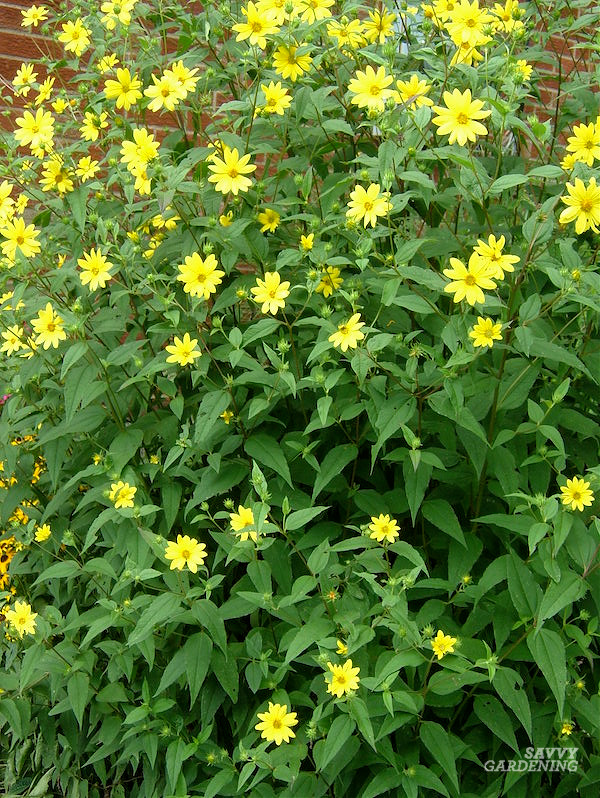This post may contain affiliate links. If you make a purchase through links on our site, we may earn a commission.
Most gardeners are familiar with sunflowers (Helianthus annuus). They are common annuals with bright blooms that live for a single growing season. But did you know that there are more than 60 other species of sunflower in the genus Helianthus, a good number of which are perennials? Yes, that’s right. Perennial sunflowers! These beautiful flowering plants return to the garden year after year. In this article, I’ll introduce you to several of my favorite types of perennial sunflowers.

What are perennial sunflowers?
These members of the daisy family (Asteraceae) are types of sunflowers that live for many years. Most species are native to North America where they live in wild plant communities such as prairies and woodlands, depending on the specific species. They look so lovely growing in partnership with native meadow grasses and other flowering plants.
Like all members of the Asteraceae family, perennial sunflowers have daisy-like flowers with a central core of multiple tiny blooms surrounded by brightly colored petals. Most are tall, except those with cultivars that have been bred to be short in stature. Many perennial sunflowers are late blooming and all require full sun, though there are a few species noted below that tolerate partial shade.

Where to grow perennial sunflowers
Perennial sunflowers are tolerant of a wide range of soil conditions, but well-draining soil high in organic matter is best. Some species tolerate poorly drained soils or even those that are occasionally flooded. With their late bloom time (sometimes mine are still in bloom in October and November!), these plants are enjoyed by pollinators and wildlife at a time when many other plants have already finished blooming. Birds enjoy feasting on the seed heads, while bees, butterflies, and other pollinating insects feed on their nectar. The majority of species mentioned in this article grow in a clump which makes them ideal for perennial beds and borders. They are also popular varieties for cut flower gardens. A few species require staking, especially if they do not receive full sun, but most stand upright on their own.

The species of perennial sunflowers I highlight in the section below are hardy in a range of USDA hardiness zones, but since most are native to multiple regions of North America, you can expect them to be winter-hardy down to about -20 to -30°F, with a few exceptions. Take note of the native geographic range of each species and look for one that matches the climate of the region where you live.
Members of the Helianthus genus support many specialist bees that only drink nectar and eat pollen from a small group of plants. These plants are valuable additions to the garden. For the most part, Helianthus is deer-resistant, though the deer at my house have been known to nibble the newly emerging plant stems early in the spring.

Types of perennial sunflowers for the garden
Here are details about 7 of my favorite types of perennial sunflowers. They are all stunning additions to the garden – no matter which one you choose, you can’t go wrong!
Rough perennial sunflowers
Helianthus divaricatus. Also known as the woodland sunflower, this species grows 5 to 7 feet tall. It’s native to the eastern and central North America. The opposite leaves with no stems are a distinguishing feature. This is my favorite of all the perennial sunflowers, and I have several clumps at my house. The plant is smothered in 2-inch-wide bright yellow flowers with anywhere from 8 to 15 petals from early summer through fall. It makes a great addition to pollinator gardens, though I do have to support my plants to keep them from flopping over. They are on the west side of my house and receive bright afternoon sun, but they are shaded by the house during the morning hours. The plants are easy to divide. They are clump forming and do not spread by runners or rhizomes. I find they have good drought tolerance as well.

Maximilian or Michaelmas sunflowers
Helianthus maximiliana. This giant prairie sunflower is a real showstopper. Not only is it easy to grow from seed, but it produces multiple 3- to 6-inch-wide flowers along the length of tall, upright stems from the leaf axils. Each stem produces between 15 and 19 individual blooms. The flowers open from the bottom of the stem to the top as the season progresses. Maximilian sunflowers are native through the central portion of North America and the seeds are enjoyed by many species of birds. It’s also the larval host plant for the silvery checkerspot butterfly. The Maximilian sunflower grows 3 to 10 feet tall, which means it makes a great statement in the garden. My favorite variety of Maximilian’s sunflower is ‘Dakota Sunshine’ (see photo).

Narrow Leaf Perennial Sunflowers
Helianthus angustifolius. Also known as the swamp sunflower because of its preference for moist to wet soils, this beauty is native from southern New England down and across to Texas. It can reach 8 feet tall and produce oodles of cheery yellow 1- to 3-inch-wide flowers from mid summer into fall. A quick pinch to remove the terminal portion of each stem in early June results in a more compact plant with more branches and therefor more flowers.
Unlike most other perennial sunflowers, the narrow leaf sunflower tolerates partial shade, though you’ll see better flowering in full sun. A few cultivars are shorter in stature and do not require staking. These include ‘Low Down’ and ‘First Light’. It’s terrific along streams or next to ponds. As with other perennial sunflowers, it’s a draw for pollinators and is in bloom when many other perennials have stopped flowering. Plus, it’s another host plant for the silvery checkerspot butterfly.

Small-headed sunflower
Helianthus microcephalus. An additional common name for this lovely member of the perennial sunflowers group is the small woodland sunflower. It’s found often along roadsides across eastern North America from southern Canada down to Georgia. The plant grows 4 to 6 feet tall and is covered in clusters of yellow blooms. It’s a variety of perennial sunflower that tolerates moist to dry soil and will even do okay in partial shade. It’s easy to divide and share with friends. It also readily self-seeds, leading to naturalization (cut off the spent blooms if you don’t want it to do so). Butterflies adore it and not just for its nectar. The small-headed sunflower is a host plant for the American painted lady, painted lady, silvery checkerspot, and spring azure butterflies. Topping out between 4 and 6 inches in height, it’s covered in 1- to 3-inch-wide blooms from late summer through fall.

Thin-leaved perennial sunflowers
Helianthus x multiflorus. These hybrids with double-petaled flowers are thought to be the result of a cross between annual sunflowers and a perennial sunflower species known as Helianthus decapetalus. There are several cultivars, including ‘Capenoch Star’, which grows to 4 feet, ‘Loddon Gold’ which reaches 6 feet, and ‘Sunshine Daydream’ which has a height of 5 feet. The blooms are pom-pom like and the plants are tolerant of high humidity and do not require staking.

Western sunflower
Helianthus occidentalis. This North American native perennial sunflower reaches 4 feet in height and produces orange-yellow blooms in late summer and early fall. Full sun is best for this species, but it tolerates poor or sandy soils and droughts. The creeping rhizomes cause the plant to spread easily to create colonies. It’s among the shortest of our native perennial sunflowers. The stems are nearly leaf-less. Funnily enough, in spite of its common name of western sunflower, this species is native to the eastern and central part of the continent. Many birds enjoy the seeds.

Jerusalem artichokes
Helianthus tuberosus. This edible perennial sunflower produces fleshy, edible tubers below ground. Harvest the tubers in the fall. As long as a few tubers are left behind, the plant will continue to grow. The plants reach 4 to 5 feet tall and produce beautiful blooms with yellow petals late in the season. They are native to much of North America and are so easy to grow that they can become invasive.

More about these great plants
There are many other species of perennial sunflowers in addition to these seven, including the beach sunflower (Helianthus debilis), the willowleaf sunflower (Helianthus salicifolius which has a compact cultivar named ‘Autumn Gold’), Helianthus ‘Suncatcher’ which is a compact hybrid perennial variety that’s great for containers. All of these have similar care needs as the species mentioned above. All types of perennial sunflowers are easy to divide and transplant when the stem clusters grow too large and begin to thin out at their center.

Discover more great perennials for your garden by visiting the following articles:
- Shade-loving perennial choices
- Shasta daisies for the win
- Daylilies and how to grow them
- Hardy hibiscus for tropical blooms
- Tall perennials for the back of the border
Pin it!




Leave a Reply